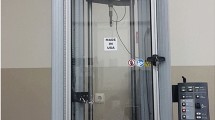Abstract
The influence of glass transition temperature (Tg) on the high velocity (>100 m/s) impact performance was investigated for a model thermosetting resin composite system. Plain weave S-2 glass composite panels were fabricated using VARTM and an epoxy resin cured with a polyetheramine curing agent. Overall, the energy absorption for the composite remained approximately constant over a broad testing temperature (T) range. The damage area caused by high-strain rate delamination, however, showed remarkable dependence on the glass transition temperature when plotted against T-Tg. The damage area was high in the glassy state (low T-Tg values) and decreased as the resin traversed its Tg into the rubbery region. Impacted samples showed that an increase in back face deflection correlated to lower damage areas and a paradigm shift in energy absorption mechanisms. These results illustrate the critical importance of the temperature dependent viscoelastic behavior on the impact properties of composites.
Access this chapter
Tax calculation will be finalised at checkout
Purchases are for personal use only
Similar content being viewed by others
References
Wilkins, M.: Second Progress Report of Light Armor Program. California Univ., Lawrence Livermore Lab, Livermore (1967)
Wilkins, M.L., Cline, C.F., Honodel, C.A.: Fourth Progress Report of Light Armor Program. University of California Livermore, Livermore (1969)
DeLuca, E., et al.: Ballistic impact damage of S 2-glass-reinforced plastic structural armor. Compos. Sci. Technol. 58(9), 1453–1461 (1998)
Hazell, P.J., Appleby-Thomas, G.J.: The impact of structural composite materials. Part 1: ballistic impact. J. Strain Anal. Eng. Des. 47(7), 396–405 (2012)
Scott, B.: New Ballistic Products and Technologies in Lightweight Ballistic Composites, pp. 336–363. Elsevier, Amsterdam (2006)
Cantwell, W.J., Morton, J.: The impact resistance of composite materials—a review. Composites. 22(5), 347–362 (1991)
Razali, N., et al.: Impact damage on composite structures – a review. Int. J. Eng. Sci. 3(7), 8–20 (2014)
Bartus, S.D., Vaidya, U.K.: A review: impact damage of composite materials. J. Adv. Mater. 39(3), 3–21 (2007)
Kasano, H.: Recent advances in high-velocity impact perforation of fiber composite laminates. JSME Int. J. Ser. a-Solid Mech. Mater. Eng. 42(2), 147–157 (1999)
Reddy, P.R.S., et al.: Effect of viscoelastic behaviour of glass laminates on their energy absorption subjected to high velocity impact. Mater. Des. 98, 272–279 (2016)
Faur-Csukat, G.: A study on the ballistic performance of composites. Macromol. Symp. 239, 217–226 (2006)
Sarlin, E., et al.: Impact properties of novel corrosion resistant hybrid structures. Compos. Struct. 108, 886–893 (2014)
Sarlin, E., et al.: The effect of test parameters on the impact resistance of a stainless steel/rubber/composite hybrid structure. Compos. Struct. 113, 469–475 (2014)
Bibo, G., et al.: High-temperature damage tolerance of carbon fibre-reinforced plastics: part 1: impact characteristics. Composites. 25(6), 414–424 (1994)
Ma, H.-l., et al.: Impact properties of glass fiber/epoxy composites at cryogenic environment. Compos. Part B. 92, 210–217 (2016)
Im, K.-H., et al.: Effects of temperature on impact damages in CFRP composite laminates. Compos. Part B. 32(8), 669–682 (2001)
Gómez-del Rı́o, T., et al.: Damage in CFRPs due to low velocity impact at low temperature. Compos. Part B. 36(1), 41–50 (2005)
Machado, J., et al.: Mode I fracture toughness of CFRP as a function of temperature and strain rate. J. Compos. Mater. 51(23), 3315–3326 (2017)
Machado, J.J.M., et al.: Mode II fracture toughness of CFRP as a function of temperature and strain rate. Compos. Part B. 114, 311–318 (2017)
Knorr Jr., D.B., et al.: Glass transition dependence of ultrahigh strain rate response in amine cured epoxy resins. Polymer. 53(25), 5917–5923 (2012)
Masser, K.A., et al.: Temperature dependent impact performance and the configurational entropy of polymer networks. J. Polym. Sci. B Polym. Phys. 57, 511–523 (2018)
Knorr Jr., D.B., et al.: Overcoming the structural versus energy dissipation trade-off in highly crosslinked polymer networks: ultrahigh strain rate response in polydicyclopentadiene. Compos. Sci. Technol. 114, 17–25 (2015)
Elder, R., et al.: Mechanics and nanovoid nucleation dynamics: effects of polar functionality in glassy polymer networks. Soft Matter. 14, 8895–8911 (2018)
Elder, R.M., et al.: Nanovoid formation and mechanics: a comparison of poly (dicyclopentadiene) and epoxy networks from molecular dynamics simulations. Soft Matter. 12(19), 4418–4434 (2016)
MIL-STD, U.M.S.: 662F, V50 Ballistic Test for Armor. US Army Research Laboratory, Weapons & Materials Research Directorate, Aberdeen Proving Ground, MD (1997)
Zee, R.H., Hsieh, C.Y.: Energy loss partitioning during ballistic impact of polymer composites. Polym. Compos. 14(3), 265–271 (1993)
Acknowledgements
Research was sponsored by the Army Research Laboratory and was accomplished under Cooperative Agreement Number W911NF-18-2-0304. The views and conclusions contained in this document are those of the authors and should not be interpreted as representing the official policies, either expressed or implied, of the Army Research Laboratory or the U.S. Government. The U.S. Government is authorized to reproduce and distribute reprints for Government purposes notwithstanding any copyright notation herein.
Author information
Authors and Affiliations
Editor information
Editors and Affiliations
Rights and permissions
Copyright information
© 2021 The Society for Experimental Mechanics, Inc.
About this paper
Cite this paper
Patterson, B.A., Busch, C., Masser, K.A., Knorr, D.B. (2021). Role of Glass Transition Temperature on Energy Absorption Mechanisms in High Strain Rate Impact Performance of Fiber Reinforced Composites. In: Kramer, S.L., Tighe, R. (eds) Thermomechanics & Infrared Imaging, Inverse Problem Methodologies and Mechanics of Additive & Advanced Manufactured Materials, Volume 7. Conference Proceedings of the Society for Experimental Mechanics Series. Springer, Cham. https://doi.org/10.1007/978-3-030-59864-8_16
Download citation
DOI: https://doi.org/10.1007/978-3-030-59864-8_16
Published:
Publisher Name: Springer, Cham
Print ISBN: 978-3-030-59863-1
Online ISBN: 978-3-030-59864-8
eBook Packages: EngineeringEngineering (R0)




